
Sydney Rows
A Centennial History of the Sydney Rowing Club, 1970, by A L May
Table of Contents
Chapters
- Preliminaries: before 1870
- Foundations: 1870-1880
- New Clubs: 1880-1890
- The Amateur Question: 1890-1900
- Sydney on Top: 1900-1910
- Henley and War: 1910-1920
- Pearce and Mosman: 1920-1930
- Financial Problems: 1930-1940
- War and Wood: 1940-1950
- Strength and Stability: 1950-1960
- On Top Again: 1960-1970
Appendices
10. Strength and Stability: 1950-1960
With trials for the Rome Olympics set down for April, 1960, the State championships were held early in the season over 2000 metres, and the King's Cup was rowed in March. Leichhardt and Mosman vied for top honours in the senior field, with the State championship finally going to the latter. Tutty won the sculling title and, with Webb, the double sculls. Leichhardt continued its domination of lightweight rowing, winning all five lightweight championships, while a new name was added to the championship list when Colleagues won the junior eight title.
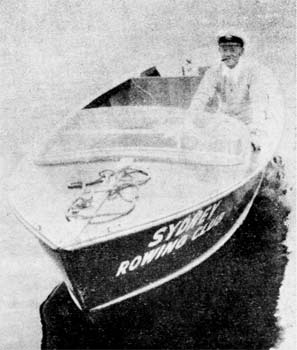
Jack McMahon at the wheel of the club's new speedboat
The winning crew in the 1960 King's Cup was to be the basis of the Australian Olympic eight. Evatt and Fred Evans were elected NSW selectors and Longley, the Mosman coach, became coach of the State crew. It comprised Railton, Hudson, Allen and Kevin and Bruce Evans of Mosman plus Currall, Waddington and Schweikert of Leichhardt. There were 15,000 people at Launceston for the big event. WA took the lead at the half-way mark with NSW passing Victoria to gain second place. NSW challenged WA at the 1500 metre mark but it was unsuccessful and Ken Grant's WA crew won by 3/4 length from NSW with Victoria 2 lengths back in third place.
Tutty was always in control in the President's Cup and beat Peter Edwards of Victoria by 3 lengths. The titleholders, WA, once again beat NSW into second place in the Penrith Cup, the winning margin being 1 1/2 lengths. A three-man grading committee of Berkery (Tasmania), Williams (Victoria) and Evatt (NSW) was set up to assess the performance of crews in the Olympic trials, held at Penrith and Ballarat. Tutty and Webb won the double sculls, while the composite Leichhardt-Mosman crew of Waddington, Annett, Allen and Hudson won the coxless four. The Melbourne University pair of Hunt and Davies won the coxless pair, Sydney's big hope of May and White finishing third. (The latter crew did, however, travel overseas and competed for Sydney at the 1960 Henley Royal Regatta.)
The coxed pair and coxed four events were won by Hunt and Davies and by the Leichhardt-Mosman combination respectively, albeit by very narrow margins. Although he had not competed in trials and had been seriously ill, Mackenzie, who had won three Diamond Sculls in a row and was shortly to win a fourth, was first in the nominations for the Olympic rowing. The eight was second, the coxless pair third and the coxed four fourth. The runner-up crew in the coxed pair, Guest and Howell of Victoria, was placed next, and Webb and Tutty sixth. The runner-up Victorian coxless four was placed seventh. In fact, sufficient finance was found to enable all crews to make the trip. Reg Blundstone of Tasmania became team manager while, for the first time, a team captain was also appointed, the evergreen Kevyn Webb being given this honour.
During the 1948/49 season-and doubtless under the influence of George Parlby - the club wrote to Thames Rowing Club in England for the plans of its four-oar rowing tank. The Thames tank must have been quite old for Derwent Rowing Club in Tasmania constructed one on its lines in 1925-and claimed it was the first of its type in the Commonwealth.Eight-oar tanks were common in the USA at least by the 1930's, when Yale, Princeton and Columbia all had one (the freezing of the rivers in winter being, of course, an additional attraction of a tank in many countries).
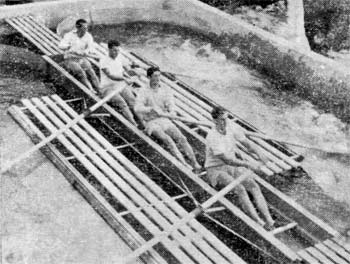
Trying out the new tank: Bill Andrews (bow), John Towers, Barry May and Bruce Cumming (stroke)
The Olympic rowing events at Lake Albano were a great disappointment for Australia. Illness prevented Mackenzie from starting but, in the other six events, only one crew - the coxed four-made the final, and it finished fifth. West Germany won three events, Russia two, and Czechoslovakia and the USA one each. The eights went to Karl Adam's West German crew, with Canada second and Czechoslovakia third, while Ivanov of Russia successfully defended his sculling title. The Australian squad returned to Australia with, at least, additional knowledge: of the scientific approach and the interval training methods of the West Germans; of the rigorous, dedicated approach of the Canadians; of the growing use of the Italian or tandem rigged boat; of the comparative heaviness of many of the Australian boats; and, above all, of the need for keener racing for Australian oarsmen, both abroad and at home.
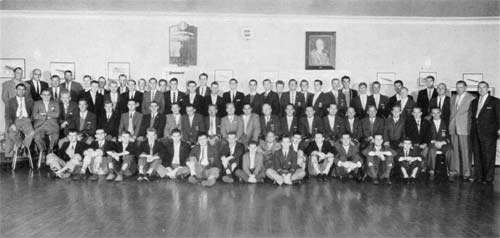
Club members Season 1959-60
Other Developments
Shore had the best results in GPS rowing in the decade, once again. The school had a new coach for the 1951 season-Bill Thomas -and they won both the Gold Cup and the Head of the River, beating Joeys by 1 1/2 lengths in the latter with King's third.
In 1952, they did even better, the eight winning the champion junior eights of NSW as well (the first-ever championship win to a school crew). The win in the Head of the River was a narrow one, however - 2 feet over Joe Gould's Grammar crew. Shore "scooped the pool" at this regatta, its four fours also winning.
A fine High eight, coached by Nichols, repeated the Shore eight's hat trick of successes in 1953. Shore was, however, second in the big event and, in 1954, was on top once again, with Newington and King's filling the minor placings. Bill Thomas now had three wins and a second from four starts.
Grammar's eight got up in 1955, beating Joeys by 1/2 length with Shore "only" third. St. Joseph's won three of the fours that year and this depth of talent paid off in 1956 when, on a flooded river, they beat King's by 3 feet with Shore 3 feet further back third. Alan Callaway became High's coach in 1957 and he had immediate success. His eight won well, beating Grammar and Shore.
1958 was a grand year for St. Ignatius', which scored its first-ever win in the big eight-oared event, Duncan Baggett being the successful coach. Shore was second and High third. High's 1959 eight was hailed as one of the best ever seen, and it scored a comfortable win over Joeys. Shore scored its first win for six years in 1960, with Scots second and High third.
Little was achieved in inducing high schools to take up rowing, efforts by the NSWRA in 1954/55 being unsuccessful. Nevertheless, Fort Street students commenced rowing as junior members of Leichhardt that year and hopes were expressed that a high schools' regatta might become a reality one day, especially in view of the progress being made in school rowing on the far north coast. After its Pearl Bay shed opened, Mosman invited schools to make use of it, but the offer was rejected. Nepean invited Penrith High School to take up rowing but also without success, the Education Department indicating that it would not allow rowing to become a major school sport.
NSW dominated interstate women's rowing in the decade. Queensland won "Bertha", the trophy for the Australian championship, in 1954, but NSW was successful in each of the other nine years. Most prominent in these victories was Margaret Agnew, with no less than seven wins from eight starts.
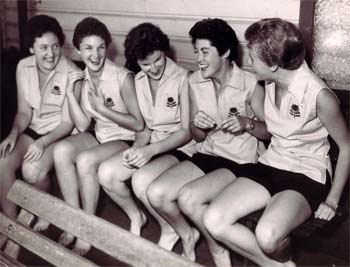
1955 NSW Women's Four
Sydney Ladies' was the only city club until 1955, when a group from the club formed Leichhardt Women's Rowing Club. Rowing as full members of Leichhardt men's club, they were very successful for a few years but, by 1960, were unable to boat a crew. Mosman Ladies' Rowing Club, inspired by Rose Evans, commenced in 1957, also making use of the men's club's facilities. They, too had immediate success. The rented boathouse being used by Sydney Ladies' burned down in May, 1953 with all the fleet being lost. Nevertheless, enthusiasm was unimpaired and, after many difficulties, a boathouse of their own was acquired in Battersea Park, Abbotsford, being opened in March, 1960.
Many significant matters again came before the AARC in the decade. The idea of a National Regatta was reconsidered in 1952 and 1953 but without attracting support. In 1959, however, it was decided to investigate the proposal further and a full report by Webb was considered at the 1960 meeting. The Council was unanimous that King's Cup events continue to be held annually, but asked the NSWRA to submit a motion for a mail vote concerning the holding of an Australian championship regatta in 1962.
The 1955 meeting decided to discontinue the double scull and pair-oar championships due to the lack of support by States but in 1958, as has been seen, the lightweight fours was added. The distance of the big races attracted much attention. The 1956 King's Cup was rowed over 2000 metres but, thereafter, it reverted to 3 miles. In 1959, the States were split 3-3 on a permanent change to 2000 metres, but in 1960 it was finally resolved that both eights and sculls should be over the Olympic distance. Official approval of a lightweight limit of 10.10-the international rule - was given in 1960.
A sad duty of the 1956 meeting was the paying of tribute to the late Edward Kenny, the former Leichhardt member who was secretary-treasurer of the AARC from 1925 until his death in April of that year at the age of 72. An appeal was started and funds raised to provide Kenny memorial medallions for future members of winning King's Cup crews.
Norm Cairnes of Victoria succeeded Kenny as secretary-treasurer and, in 1959, Reg Blundstone, a former Tasmanian interstate oarsman, was elected to the post. The presidency continued to rotate among the States, depending on which was to hold the next King's Cup regatta.
The NSWRA's problems in the decade were often financial. Despite efforts to induce the AARC to adopt a scheme under which the costs of international representation would be shared among the States, the system remained that each State contribute to expenses in accordance with the number of oarsmen each had in the total selection. This involved the RA in finding ₤1,052 in 1950, ₤327 in 1951 and ₤4,687 in 1952, apart from the financing of King's Cup crews. Heavy reliance on donations continued, although the success of the annual Melbourne Cup sweep soon eased the situation a little. Some ₤400-₤500 was raised by it in the first four years of the decade but thereafter, and largely due to the keen efforts of Ossie Rosevear, the net figure topped £1,000 each year. It even proved possible to put funds away into the International Reserve Fund - £500 in each of 1954/55 and 1955/56, £280 in 1957/58 and £450 in 1958/59 (despite the particularly heavy 1958 Empire Games expenses that year).
By the end of the decade, and including interest, the Fund had reached £1,750. Social activities aimed at fund raising were also conducted. A Ball was held in 1953 and was continued annually (with the exception of 1957 when it was cancelled three days before the due date due to lack of support). The efforts of Laurie Stepto were largely responsible for its successful reintroduction. A "Barbecue and Night of Fun" was held at Sydney Rowing Club for four years in a row from 1953 but it lapsed thereafter.
Mr. Justice Maxwell was president of the Association throughout the decade, while the chairman continued to be Harry Alderson who became, in 1956, to the delight of all rowing men, Sir Harold. Ill-health led to John Rook retiring as secretary during 1952/ 53, but he was then appointed deputy chairman and held this post for the remainder of the decade. He was succeeded as secretary by H. Scott Wilkes, John Winton, Ken Houghton, Frank Nichols and Roy Hunt. Geoff Davies was treasurer until 1955/56 when he was succeeded by Laurie Stepto. The position of honorary registrar was created in 1952/53, being filled by Harry Kerr and, later, George Parlby. In 1951/52, Eddie Dorsch of the King's School was made the Association's first life member in recognition of his assistance to the Association. Grateful acknowledgement of the continuing assistance of St. Ignatius' was also made on several occasions. Among thanks to clubs for repeated and generous assistance, the name of Sydney Rowing Club was always in a prominent position.
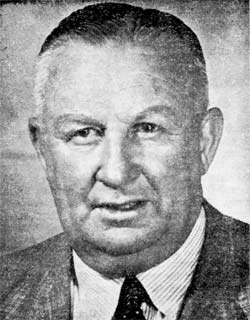
Sir Harry Alderson
Professional sculling died out completely in the decade. A number of country clubs in NSW abandoned the
professional ranks and became amateur and, while a Federation of Professional Sculling existed, it was
unable to alter the position. Evans Paddon, the champion, easily defeated Jim Saul of the Macleay in 1952
for the world title and ₤300
a side. He then announced that his great ambition was to race Merv Wood, perhaps with the proceeds of the
race going to charity. Wood was interested until the secretary of the AARC ruled that this would disqualify
him as an amateur and the idea was dropped. (At this time, meetings of professional scullers, chaired by
George Towns, took place on the premises of Sydney Rowing Club.) Saul did succeed in taking the title off
Paddon in 1954, in a close race, but, five months later in a return match, Paddon regained the title. A
new champion was emerging, however, in Evans Fischer of the Clarence River, and he finally defeated Paddon,
not once but three times. Paddon retired in 1957 and the following year, Fischer, aged only 26, retired,
undefeated champion of the world.
